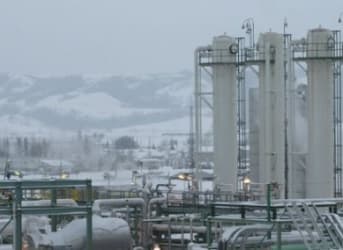New England may avoid a spike in natural gas prices this winter, but the region is becoming increasingly dependent on the fuel, ensuring that price spikes in future years are not out of the question.
A year ago, the polar vortex brought several bouts of low temperatures and heavy snow to the northeast, causing demand for heating and electricity to jump. Temporary shortages in natural gas flows due to pipeline constraints led spot prices to shoot up. Prices at Algonquin Citygate, a marker for the Boston area, hit an all-time high of $77.595 per million Btu (MMBtu) on January 23, 2014.
Thus far, this winter has been milder, and record levels of natural gas production in 2014 have restored inventories, lowering the chance of a repeat in price spikes.

And in the short-term at least, there is another reason that New England likely won’t see the dramatic price spikes this winter: more imported liquefied natural gas (LNG). Related: Wine And Gas Battle It Out In Northern US
LNG prices are correlated with the price of oil, so the collapse in oil prices have pushed down LNG prices as well. This has made LNG imports much more attractive for the eastern seaboard. In the first three weeks of 2015, two LNG terminals in New England along with the Cove Point terminal in Maryland have together imported more than three and a half times the volume of LNG that was imported during the same period a year ago.
The 10 bcf imported over the past three weeks also amounts to 30 percent more than the entire volume imported to the region last winter (November 2013 through March 2014). The extra imports have reduced the risk of price spikes from a shortage of pipeline gas.
Over the longer-term, New England is trying to add pipeline infrastructure to access more shale gas from the Marcellus. That build out is already underway – there were a few pipeline expansions that have come online since last winter, which have helped the region avoid price spikes. Transco’s Northeast pipeline completed an expansion, for example, increased natural gas capacity by 0.63 billion cubic feet per day (bcf/d) into New York City. Another 2.5 bcf/d of pipeline capacity for New England is slated for completion by the end of 2016, according to the U.S. Energy Information Administration.
Wood Mackenzie predicts that natural gas pipeline capacity from Appalachia will triple by 2018 to 16 bcf/d. Related: Natural Gas Overwhelmingly Replaces Coal
A broader web of pipelines will prevent the extraordinary price spikes seen in the winter of 2014, but a greater reliance on natural gas will also increase the chances of smaller price spikes in the future. That is because natural gas prices have been historically volatile, and it is now becoming an overwhelmingly large part of the region’s energy generation mix. For example, natural gas only accounted for 15 percent of New England’s electricity mix in 2000, but that figure has jumped to 44 percent as of 2014.
The growth in the share of natural gas has pushed out a lot of coal and oil-fired generation, no doubt a significant improvement from an air quality perspective. But with natural gas eating up a larger and larger share of the portfolio, the region risks becoming too dependent on one source of energy. An estimated 3,500 megawatts of generation (more than 10 percent of New England’s total electric capacity) are expected to be retired, mainly coal and oil generators. According to SNL Financial, that will be replaced by 9,500 megawatts of new power plant capacity, made up of 57 percent natural gas and 43 percent wind – but a lot of the wind will be in remote parts of Maine.
The New England region is already pursuing more pipelines. The challenge for the region will be to promote more non-natural gas power plant capacity – more wind and solar are needed to balance the portfolio. But that will also require the construction of new transmissions lines, which can be as much of a trial as building new pipelines.
ADVERTISEMENT
By Nick Cunningham of Oilprice.com
More Top Reads From Oilprice.com:
- Natural Gas Threatens U.S. Nuclear Future
- Crushing The U.S. Energy Export Dream
- Is Keystone Still Viable Amid Low Oil Prices?


















